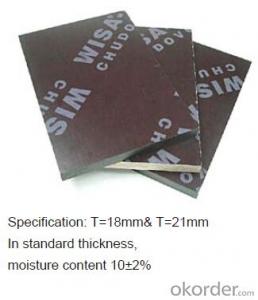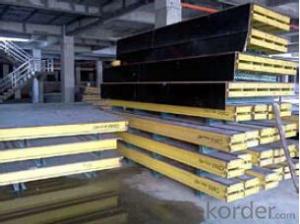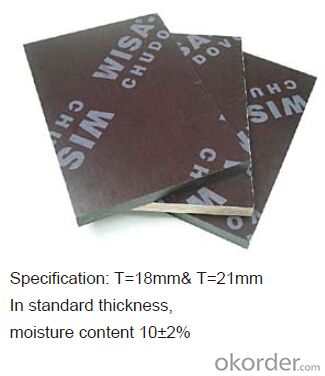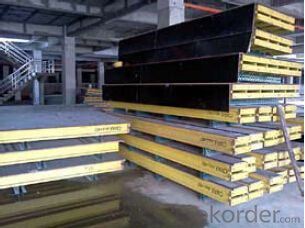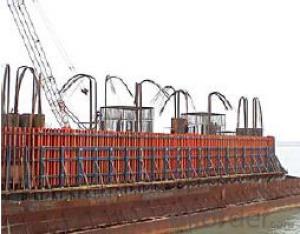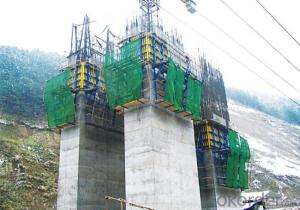Plywood formwork system for formwork and scaffolding
- Loading Port:
- Tianjin
- Payment Terms:
- TT OR LC
- Min Order Qty:
- 50 m²
- Supply Capability:
- 1000 m²/month
OKorder Service Pledge
Quality Product, Order Online Tracking, Timely Delivery
OKorder Financial Service
Credit Rating, Credit Services, Credit Purchasing
You Might Also Like
Plywood --- make perfect concrete surface
WISA-Form Birch is a coated special plywood using in the formwork systems where high
requirements are set on the concrete surface and the times of reuses.
With CNBM timber beam & WISA plywood, the formwork is low weight but high load capacity, it is
widely used in construction.
Characteristics:
◆ Component with high standardization.
◆ Assembling in site, flexible application.
◆ Light weight, easy transportation and storage.
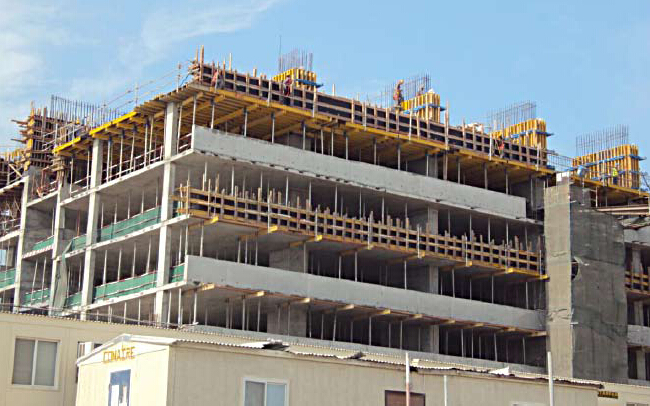
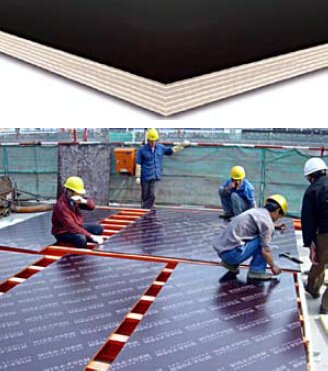
- Q: Can steel formwork be used for hotel construction projects?
- Yes, steel formwork can be used for hotel construction projects. Steel formwork is commonly used in construction due to its durability, strength, and versatility. It provides a sturdy and reliable framework for pouring concrete and can be easily assembled and dismantled, making it suitable for various construction projects, including hotel buildings.
- Q: How does steel formwork affect the overall cost of concrete placement?
- Steel formwork can significantly impact the overall cost of concrete placement due to its higher initial investment compared to other types of formwork. However, steel formwork offers advantages such as durability, reusability, and faster construction times, which can help reduce labor costs and increase productivity in the long run. Additionally, steel formwork provides a smoother finish to concrete surfaces, reducing the need for additional finishing work and potentially saving on material costs.
- Q: How does steel formwork handle different concrete surface texture requirements?
- Steel formwork is a versatile and durable option that can handle a variety of concrete surface texture requirements. With its adjustable and customizable design, it allows for different surface finishes to be achieved. One way steel formwork meets different concrete surface texture requirements is by being easily modified and adapted. By adjusting the steel formwork panels, various finishes such as smooth, textured, or patterned concrete can be accommodated. This flexibility makes it suitable for a wide range of construction projects, from simple slabs to complex structures. Additionally, steel formwork ensures a smooth and consistent surface, which is crucial for achieving the desired concrete finish. The rigid and sturdy nature of steel prevents any distortions or imperfections from occurring during the pouring and curing process, resulting in a uniform surface texture, regardless of the design's complexity. Moreover, steel formwork offers excellent resistance to wear and tear, making it suitable for projects that require repetitive use or high-volume concrete pouring. Its durability allows it to maintain its shape and integrity even after multiple uses, ensuring consistent concrete surface texture requirements are met over time. In conclusion, steel formwork is a reliable and adaptable solution for addressing various concrete surface texture requirements. Its adjustability, durability, and ability to provide a smooth and consistent surface make it an ideal choice for achieving different finishes, regardless of the project's complexity.
- Q: What are the common accessories and attachments used with steel formwork systems?
- There are several common accessories and attachments used with steel formwork systems to enhance their functionality and efficiency. Some of these include: 1. Formwork clamps: These are used to securely hold the steel formwork panels together. They provide stability and prevent any movement or shifting during the concrete pouring process. 2. Formwork ties: These are used to connect the steel formwork panels and ensure they remain in the desired position. Formwork ties help distribute the pressure evenly across the formwork, preventing any bulging or deformation. 3. Formwork props: These adjustable steel props are used to support the weight of the formwork and the freshly poured concrete. They provide additional strength and stability to the structure, ensuring proper alignment and preventing any collapse. 4. Formwork brackets: These brackets are used to attach the formwork to the existing structure or to create additional support. They help in maintaining the desired shape of the formwork and provide stability during the concrete pouring process. 5. Formwork corners: These accessories are used to create sharp corners or angles in the formwork. They ensure that the concrete is poured accurately and that the structure maintains its desired shape. 6. Formwork spacers: These are used to maintain the proper spacing between the formwork panels, ensuring that the concrete is poured evenly and uniformly. They help in achieving a smooth and even finish on the concrete surface. 7. Formwork release agents: These substances are applied to the formwork surface to prevent the concrete from sticking to the steel panels. This allows for easy removal of the formwork once the concrete has cured. 8. Formwork leveling devices: These are used to ensure that the formwork is level and properly aligned. They help in achieving a consistent and uniform concrete finish. Overall, these accessories and attachments play a crucial role in the successful implementation of steel formwork systems. They enhance the structural integrity, improve efficiency, and ensure a high-quality finish for the concrete structures being constructed.
- Q: Can steel formwork be used in retail or commercial construction projects?
- Yes, steel formwork can be used in retail or commercial construction projects. Steel formwork is a versatile and durable solution for creating concrete structures in construction projects. It offers several advantages such as high reusability, excellent dimensional stability, and the ability to handle high concrete pressures. In retail or commercial construction projects, steel formwork can be used for various applications such as constructing columns, walls, beams, slabs, and staircases. It provides a sturdy framework that ensures accurate and smooth concrete placement, resulting in high-quality finishes. Additionally, steel formwork can be easily customized and adjusted to suit different project requirements, making it suitable for projects with complex architectural designs. Furthermore, steel formwork offers significant time and cost savings in construction projects. Its reusability reduces the need for frequent formwork replacements, resulting in reduced material and labor costs. The use of steel formwork also enhances construction efficiency, as it allows for faster assembly, disassembly, and repositioning of formwork components. Overall, steel formwork is a reliable and efficient choice for retail or commercial construction projects, providing the necessary strength and flexibility required for such applications.
- Q: How does steel formwork contribute to the overall sustainability of a structure?
- Steel formwork contributes to the overall sustainability of a structure in several ways. Firstly, steel is a highly durable material that can withstand extreme weather conditions and resist corrosion. This means that steel formwork can be reused multiple times, reducing the need for new formwork to be manufactured for each construction project. By reducing the demand for new materials, steel formwork helps to conserve natural resources and minimize the environmental impact associated with the extraction and production of new materials. Additionally, steel formwork allows for efficient and precise construction processes. Its strength and rigidity enable it to support heavy loads and provide stability during concrete pouring. This facilitates faster construction time, reducing labor costs and minimizing the use of construction equipment. The efficiency and precision provided by steel formwork contribute to the overall sustainability of a structure by conserving energy and reducing waste. Moreover, steel formwork is a versatile and flexible option that can be easily adjusted or modified to meet changing construction needs. This adaptability allows for the reuse of formwork in different projects, reducing the amount of waste generated. Furthermore, steel formwork can be recycled at the end of its lifespan, contributing to the circular economy by reducing landfill waste and minimizing the environmental impact associated with disposal. Overall, steel formwork promotes sustainability in construction by reducing the need for new materials, conserving energy, minimizing waste, and facilitating efficient construction processes. Its durability, reusability, adaptability, and recyclability make it an environmentally friendly choice that contributes to the long-term sustainability of structures.
- Q: Can steel formwork be used for concrete structures in marine environments?
- Special considerations and precautions are necessary when using steel formwork for concrete structures in marine environments. The high levels of saltwater exposure and corrosive elements in marine environments present unique challenges for steel formwork. The steel formwork can rapidly deteriorate and rust due to the corrosive nature of seawater, which compromises its structural integrity. To mitigate these risks, it is crucial to utilize high-quality corrosion-resistant steel, such as stainless steel or galvanized steel, for the formwork. These materials have superior resistance to corrosion and can withstand the harsh marine environment for an extended period. Furthermore, proper maintenance and regular inspection are essential to promptly identify any signs of corrosion or damage and address them. This maintenance may involve regular cleaning of the formwork to remove accumulated salt or debris and applying protective coatings to prevent corrosion. Additionally, it is vital to consider the design of the formwork to ensure effective drainage and minimize water exposure. Adequate provision should be made for drainage channels and weep holes to prevent water accumulation, which can accelerate corrosion. In conclusion, successful use of steel formwork in marine environments requires careful selection of corrosion-resistant materials, regular maintenance, and proper design considerations. It is advisable to consult experienced professionals and engineers with expertise in marine construction to ensure the durability and longevity of concrete structures in such environments.
- Q: What are the different accessories required for steel formwork maintenance?
- The different accessories required for steel formwork maintenance include the following: 1. Formwork cleaning agents: These are used to remove any concrete residue or build-up on the steel formwork. They help in maintaining the smooth surface of the formwork and prevent any damage or corrosion. 2. Formwork release agents: These are applied to the steel formwork before pouring concrete to prevent it from sticking to the formwork. They help in easy removal of the formwork after the concrete has cured. 3. Formwork patching compounds: These are used to repair any damages or imperfections on the steel formwork. They help in maintaining the structural integrity of the formwork and ensure its longevity. 4. Formwork oil or grease: These lubricants are applied to the moving parts of the steel formwork, such as hinges or sliding mechanisms. They help in smooth operation and prevent any friction or wear and tear. 5. Formwork ties and connectors: These are used to secure the formwork panels together and ensure stability during concrete pouring. They should be regularly inspected and replaced if damaged or worn out. 6. Formwork wedges and pins: These are used to align and secure the formwork panels in place. They should be checked regularly to ensure proper positioning and stability. 7. Formwork clamps and brackets: These accessories are used to support and hold the formwork panels in position. They should be inspected for any signs of damage or weakness and replaced if necessary. 8. Formwork cleaning tools: These include brushes, scrapers, and high-pressure washers, which are used to clean the steel formwork. Regular cleaning helps in maintaining the formwork's appearance and prevents the accumulation of dirt or debris. 9. Formwork storage and transportation equipment: These include racks, trolleys, or storage containers, which are used to store and transport the steel formwork safely. Proper storage and transportation ensure the formwork's longevity and prevent any damage or distortion. Overall, the different accessories required for steel formwork maintenance are crucial to ensure the formwork's optimal performance, durability, and safety during concrete construction projects.
- Q: How does steel formwork contribute to the speed of construction?
- Steel formwork contributes to the speed of construction in several ways. Firstly, steel is a highly durable and strong material, allowing for faster construction processes as it can withstand the pressure and weight of the concrete. This means that larger sections of formwork can be used, reducing the number of individual components and therefore speeding up the assembly process. Secondly, steel formwork is highly reusable. Unlike traditional timber formwork, steel formwork can be used for multiple construction projects, reducing the need for new materials and saving time and resources. This reusability also means that the formwork can be easily assembled and disassembled, allowing for faster turnaround times between projects. Additionally, steel formwork is highly adaptable and customizable. It can be easily adjusted to fit different shapes and sizes, allowing for versatile use in various construction projects. This flexibility eliminates the need for custom-made formwork, which can be time-consuming and costly. Furthermore, steel formwork is resistant to weather conditions, unlike timber formwork that can be affected by moisture and temperature changes. This resilience allows construction projects to progress even in adverse weather conditions, minimizing delays and maintaining construction speed. Lastly, steel formwork provides a smooth and even finish to the concrete structure. This eliminates the need for additional finishing work, such as plastering or sanding, which can be time-consuming and add to the overall construction timeline. In summary, steel formwork contributes to the speed of construction through its durability, reusability, adaptability, weather resistance, and ability to provide a smooth finish. These factors combine to reduce construction time, improve efficiency, and ultimately accelerate the overall construction process.
- Q: How does steel formwork affect the overall fire resistance of a structure?
- Steel formwork does not directly affect the overall fire resistance of a structure as it is primarily used for temporary support during concrete pouring and construction. The fire resistance of a structure is generally determined by the materials used in its construction, such as the type of concrete, insulation, and fireproofing systems. However, steel formwork can indirectly contribute to the fire resistance by ensuring the proper placement and compaction of concrete, which is a key factor in achieving the desired fire resistance rating. The strength and durability of the concrete, when properly mixed and compacted, can enhance the overall fire resistance of the structure. Additionally, steel formwork can provide a smooth and uniform surface finish, which can facilitate the application of fireproofing materials. Fireproofing coatings or sprays are often used to enhance the fire resistance of structural elements, such as beams and columns. The smooth surface provided by steel formwork can help ensure an even and effective application of these fireproofing materials, further enhancing the fire resistance of the structure. It is important to note that while steel formwork itself is not fire resistant, it is typically removed once the concrete has cured, and the final fire resistance of the structure is determined by the materials used in its permanent construction.
Send your message to us
Plywood formwork system for formwork and scaffolding
- Loading Port:
- Tianjin
- Payment Terms:
- TT OR LC
- Min Order Qty:
- 50 m²
- Supply Capability:
- 1000 m²/month
OKorder Service Pledge
Quality Product, Order Online Tracking, Timely Delivery
OKorder Financial Service
Credit Rating, Credit Services, Credit Purchasing
Similar products
Hot products
Hot Searches
Related keywords
